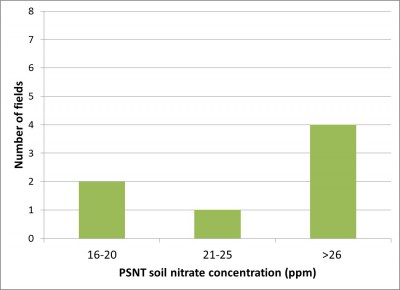By George Silva, Extension Senior Educator
A summary of the 2016 pre-sidedress soil nitrate tests (PSNT) indicates PSNT is a useful nitrogen management tool on corn fields with repeated manure practices.
The distribution of soil nitrate-N concentrations as demonstrated by 2016 pre-sidedress soil nitrate tests (PSNT) on seven corn fields, each with a history of repeated manure practices, is shown in Figure 1.
The PSNT soil samples were taken in early to mid-June, a few days prior to the planned N sidedress date. A high level of N mineralization was expected on these fields. Mineralization is the process by which microorganisms decompose organic forms of N from manure, bio-solids and crop residues to plant-available, inorganic forms of N (first to ammonium N and then to nitrate N form). This process is most rapid when soil is warm (67-86 degrees Fahrenheit), moist and well-aerated.
The observed variability in nitrate N in the soil samples is a reflection of the diversity in type, amount and frequencies of manure applied, and site-specific soil and climatic factors influencing N mineralization and environmental losses. In light of this variability, the PSNT has to be done every year to determine the level of N credit. Corn producers are then able to adjust their N sidedress rates accordingly.

Four out of the seven samples exceeded the critical nitrate-N level of 26 parts per million (ppm) or greater, thus requiring no additional N fertilizer and generating considerable cost savings to producers. The other three samples received varying amounts of N credit, based on the Maximum Return to Nitrogen (MRTN) recommendations approach (Table 1).
*This N credit applied only to corn.
Even though this test takes some time, effort and cost, the 2016 data again demonstrates the usefulness of PSNT as a cost saving tool for N management when done properly. Choosing the right fields and preparation work goes a long way towards realizing the full benefits of PSNT. For more information, see “Prep work for PSNT” by Michigan State University Extension.
Reducing synthetic N fertilizer applied to corn not only means considerable economic savings, but also environmental stewardship by minimizing N losses to the environment.





